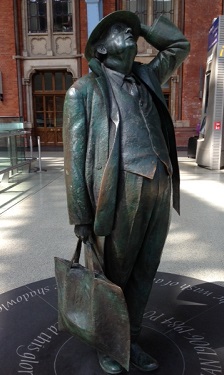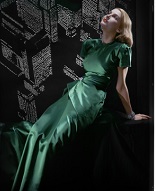
I’d been told to meet my guide Mark at 1020am by the Sir John Betjeman (poet Laureate and a key mover in the preservation of much Victorian heritage) statue and it took me a while to find it on the upper level of St Pancras station. If he’d mentioned that it was at the end of the long champagne bar and in plain sight of those elevated cloud structures it might have saved a little time!
To kick off, Mark explained that we are half way through a 25 year redevelopment of 67 acres around King’s Cross. Thankfully, he didn’t plan to take us across all of it during the 90 minute tour. He did, however, encourage us to look more closely at the Love Actually inspired nine-metre sculpture ‘The Meeting Place’ by British artist, Paul Day. The friezes around the base are incredible.
Rail history
Having gazed at the 18,000 panels of glass on the roof, I learned the reason why two major stations were built so close to each – private enterprise. St Pancras (red brick) was owned by Midlands Railway and King’s Cross (yellow brick) by Great Northern Railway (it now operates East Coast Mainline). In the early 1800s the area was practically countryside albeit an important transport hub for the river Fleet (now routed underground), the canals and the road outside which was originally used like an M25 to transport cattle around the city to market.
Mark talked about the fine red brick and terracotta of the Midlands Grand Hotel designed by Sir George Gilbert Scott (closed in 1935 and used as offices, but today reborn as the St Pancras Renaissance hotel, bars and restaurants) and mentioned that it had the first ladies smoking room in London.
St Pancras Old Church
This was one of the first Christian places of worship in London. When we visited, there was a funeral in progress so we couldn’t enter but the grounds contained a number of interesting features. For example, there is the family grave of architect Sir John Soane on which the London telephone boxes are modelled.
There’s also a memorial funded by one of the Coutts banking family heiresses and while we looked at the statue of her favourite dog, we heard her rather unhappy story. But the highlight for me was the “Hardy Tree” – the famous author started life as an architect and this tree grows up through an amazing arrangement of gravestones.
Our guide also mentioned the history of the local medical centre and pointed out the new Crick biosciences building that is currently under construction nearby.
Camley Street Gardens
Camley Street Natural Park, supported by the London Wildlife Trust, was created from an old coal yard back in 1984. We didn’t have time for a visit (although I’ve put it on my list) but we did stop to admire the amazing plants and flowers on the living wall outside.
Waterside campus
We wandered along the canal side to the University of the Arts London (UAL) building which houses Central Saint Martin’s College of Arts and Design. Whilst watching the students soak up the sun on the terraces leading down to the water, we climbed up a viewing platform and discovered which buildings had originally been granaries, coal yards, stores for potatoes and fish and stables. Then we walked past the ground fountains and into the main building to take a look at a large model of the area in the visitor’s centre.
Mark also told us that the new road (King's Boulevard) had become an international street food centre and pointed out the construction works for what will be the new European headquarters of Google. I was interested to learn that within all the new residential developments, 40% would be affordable.
King’s Place and the Canal Boat Museum
The tour took us to a large water basin behind King’s Place. I guess it’s what the Canary Wharf water expanses would look like if the British had designed it. The Canal Boat Museum is located on the former location of the Italian-Swiss Gatti ice cream empire and we were told about how blocks of ice from Norway were stored underground. The area is studded with works of metal art as there is a foundry nearby.
We did a quick tour inside King’s Place which is home to an art gallery (I saw a lovely bronze sculpture of an upturned woodlouse), the offices of The Guardian and The Observer and two orchestras and hosts events such as Jewish Book Week. One of the concert halls is made entirely from the wood of a single oak tree.
Harry Potter
We ended up back at King’s Cross station and admired the incredible lattice ceiling designed by British architect McAslan. And of course, we took a look at the new Harry Potter shop and the embedded luggage trolley at the site of platform nine and three quarters. There was a queue of people lining up to have their photos taken with a Hogwarts scarf around their necks.
Other features
We sneaked a peek at many other features as we wandered about including the “Identified Flying Object” – a large bird cage structure that sometimes contains a swing, some moveable skip gardens and the German Gymnasium which is now a bar/restaurant.
London trivia
I learned all sorts of interesting trivia about the layers of history during the tour. For example, the King’s Cross area was originally known as Battle Bridge – although which battle was unknown. And it was later named after a statue of an unpopular king that was removed. There is a legend that the body of Queen Boudicca is buried beneath platform nine. And Waterloo used to have a “Necropolis Line” where the bodies moved from graves in the area to another site in Surrey.
For further information about Mark King’s guided tours of London please contact: [email protected]
There’s further information about the King’s Cross development here http://www.kingscross.co.uk/the-development


